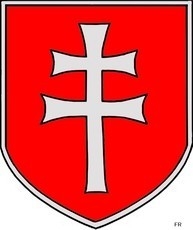1048-1061 Herzog, 1061 Kiraly
Koning van Hongarije van 1061 tot 1063 en behoorde tot het huis van Árpád.
Béla was een zoon van hertog Vazul van Hongarije en van Katun van Bulgarije. Na de mislukte opstand van zijn vader werd hij samen met zijn broers verbannen. Hij woonde eerst in Bohemen en daarna in Polen. Béla vocht in het leger van koning Mieszko II Lambert van Polen en zou een opstand van de Pommeren hebben bedwongen door de aanvoerder van de opstandelingen in een tweegevecht te verslaan. Hij werd in Polen gedoopt met de naam Adalbert en trouwde met een Poolse prinses. Béla steunde zijn zwager Casimir I van Polen om de macht van het Poolse koningshuis te vestigen.
In 1047 werd zijn oudere broer Andreas koning van Hongarije. Béla werd benoemd tot hertog tussen de Morava (Tsjechië) en de Hron. In die functie was hij veldheer tegen Kroatië en Bulgarije. Béla leek de aangewezen troonopvolger maar toen Andreas zijn 5-jarige zoon Salomon tot medekoning kroonde, vluchtte Béla naar Polen. Met een Pools leger wist hij in twee veldslagen Andreas te verslaan, diein 1060 in gevangenschap aan zijn verwondingen bezweek. Diens vrouw wist echter met Salomon en de schatkist naar Duitsland te vluchten. Béla werd koning van Hongarije maar de Duitse regentes Agnes steunde Salomon als tegenkoning.
Toen de landdag in 1061 het herstel van het heidendom eiste, liet hij de landdag door troepen uiteen jagen. Béla hervormde het muntwezen en de economie. In 1063 trok een Duits leger onder Otto I vanNortheim naar Hongarije om Salomon op de troon te zetten. Het kwam niet tot een veldslag want Béla raakte zwaargewond toen de baldakijn van zijn troon in zijn paleis in Dömös instortte, en overleedkort daarna. Béla werd begraven in de abdij van Szekszárd die hij in 1061 had gesticht.
Béla was gehuwd met de Poolse koningsdochter Richezza, dochter van Mieszko II Lambert. Zij hadden volgende kinderen:
Géza I van Hongarije, koning in 1074-1077 Lanka, gehuwd met Rostislav van Rostov Veliki Sophia (-1095), huwde een eerste maal rond 1062 met Ulrich I van Weimar, markgraaf van Carniola, graaf van Istrië (-1070) en een tweede maal rond 1071 met Magnus van Saksen Ladislaus I van Hongarije koning in 1077-1095 Euphemia (Ludmilla) (-1111), huwde met prins Otto I de Schone van Moravië-Olmütz (-1087) Maria, (rond 1053/55-); huwde met Andronicus Dukas, medekeizer van Byzantium, zoon van Constantijn X van Byzantium Lampert, hertog van Nitra in 1077-1095 Helena (Ilona), huwde met de koning van Kroatië Dmitar Zvonimir (1075-1089) Béla had ook nog een onechte dochter Sophia, getrouwd met graaf Lambert Hont-Pázmány.
Béla I the Champion or the Bison (Hungarian: I. (Bajnok/Bölény) Béla) (c. 1016 – 11 September 1063), King of Hungary (1060-1063). He descended from a younger branch of the Árpád dynasty and spent seventeen years in exile, probably in the court of the Kings of Poland. He came back to Hungary at the request of his brother, King Andrew I who assigned him the government of one third of the kingdom. However, Béla did not want to accept the hereditary rights of his brother's son, Solomon to the throne and he rebelled against his brother. Although, he managed to ascend to the throne after defeating King Andrew, he could not strengthen his reign and ensure his sons' succession. Early years Béla was the second[1] son of Duke Vazul, a cousin of Stephan I, the first King of Hungary. His mother was probably the concubine (a daughter of a member of the Hungarian gens Tátony) of his father, who still followed pagan customs[2]. On September 2, 1031, King Stephen I's only surviving son Imre was killed by a boar while hunting. King Stephen I wanted to secure the position of the Christianity in his semi-converted kingdom; therefore he was planning to name his sister's son, Peter Urseolo as his successor. However, Duke Vazul, who was suspected to be following pagan customs, took part in a conspiracy aimed at the murder of the king. But the assassination attempt failed and Duke Vazul had is eyes gouged out and molten lead poured in his ears and his three sons were exiled. In exile After their father's tragic death, the three brothers were obliged to leave the country. Fleeing first to Bohemia, they continued to Poland where Béla settled down, while his brothers, Levente and Andre continued on, settling in Kiev. In Poland, Béla served King Mieszko II Lambert of Poland and took part in the king's campaigns against the pagan Pomeran tribes. He became a successful military leader, and the king gave his daughter[3] in marriage to him. He may have been baptized just before his marriage, and his Christian name was Adalbert. After his marriage, he probably lived in Poland even during the time of interregnum when his brother-in-law, King Casimir I of Poland was obliged to leave the country. Some authors claim that during the interregnum in Poland, Béla fled to Bohemia and they identify Béla with "King Stephen's cousin", mentioned in medieval chronicles [4], whom the Emperor Henry III, in 1043, assigned to govern the parts of Hungary he had occupied from King Samuel Aba, when the Hungarians refused to accept King Peter's rule. Duke of Tercia pars Regni In the meantime, after a sanguine pagan revolt which ended the rule of King Peter, Béla's brother ascended the throne in Hungary as King Andrew I. However, his relations with the Holy Roman Empire remained tense, because King Peter had been not only a close ally of the Emperor Henry III, but he also had become a vassal of the Holy Roman Empire. King Andrew sent an embassy to the imperial court and offered to accept the Emperor's supremacy, but Henry III refused the peace; therefore the new King of Hungary had to make preparations for the approaching war. That was the reason he invited his younger brother, the successful military leader, Béla to his court, and Béla accepted his offer. In 1048, Andrew conceded one third of Hungary (Tercia pars Regni) in appanage to Béla.[5]. The two brothers shared power without incident until 1053, when King Andrew fathered a son, Solomon. Thereafter, Andrew became determined to secure the throne for his son and to displace his brother. Andrew, therefore, had his son (Béla's nephew) crowned "junior king" (rex iunior) in 1057. Following the coronation, Béla left his brother's court. In two years later, according to legend, King Andrew called back Béla to his court, and placed before him a crown and a sword, representing royal and ducal power, respectively, and asked Béla to take his choice. Knowing that choosing the crown would mean his life, Béla instead selected the sword. Shortly afterwards, Béla fled to Poland where he was received by King Boleslaw II of Poland, nephew of his wife. King of Hungary In 1060, Béla returned to Hungary and defeated King Andrew I to become the new king. After his brother's death and Béla's victory at the Theben Pass, Béla was crowned king on December 6, 1060. During his brief reign he concerned himself with crushing pagan revolts in his kingdom. Hungarian chroniclers praised Béla for introducing new currency, such as the silver denarius, and for his benevolence to the former followers of his nephew, Solomon. Béla died in an accident when his throne's canopy collapsed. After Béla's death, King Henry IV of Germany installed Solomon as the new king and Béla's male progenies had to flee to Poland again.
Laatst gewijzigd:
18 november 2020
link:
https://ngv-stambomen.nl/Hagenbeek/5783
Gekopieerd!
E-mail een vraag aan Cees Hagenbeek over deze persoon.




